Last Updated: August 4, 2025
Having moved to Costa Rica from the United States, we weren’t sure what to expect when we received our first Costa Rican wedding invitation. Feeling a bit out of place, we definitely needed to research proper etiquette and traditions. What should we wear? What gifts are appropriate? How would this wedding differ from those we’d attended in the US? In this post, we’ll share what we learned about Costa Rican wedding traditions from attending two authentic ceremonies.
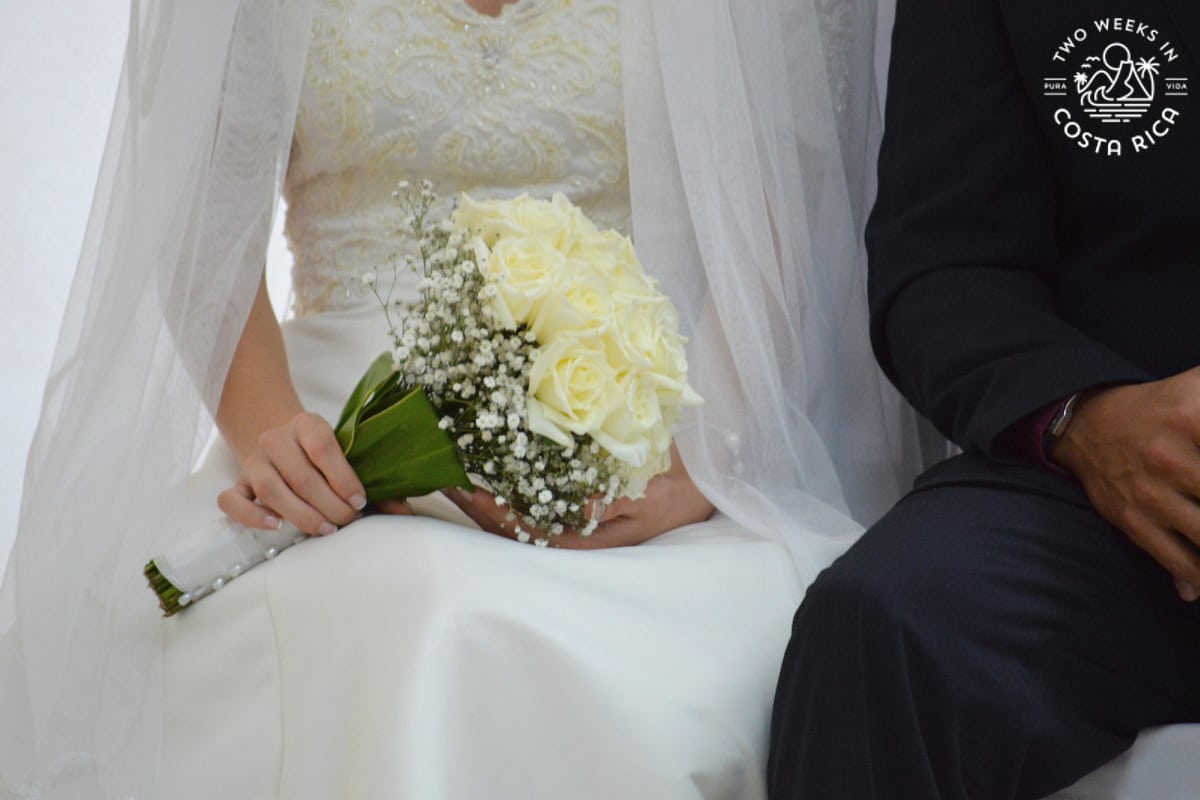
Background
The first Costa Rican wedding we were invited to came just a few months after moving to Costa Rica. That wedding was for our close friend Roy. If you’ve read our book, Two Weeks in Costa Rica, you’ll remember him well. He worked with Matt in the States and was the one who convinced us to visit Costa Rica in the first place. We obviously loved it, having moved here a few years later. That’s the short version of Our Story.
The second wedding we attended was for the daughter of the nanny we had for our oldest son. She and her large family were our neighbors in Dominical on the southern Pacific coast for many years, and we grew quite close.
Traditional Costa Rican Wedding Customs
As two foreigners attending Tico (nickname for Costa Ricans) weddings, we had to do some research on the proper Costa Rican wedding traditions and etiquette first. All we needed was to show up wearing a certain color dress or tie only to learn that the color symbolized bad luck, sorrow, or worse, failed marriages. The Ticos are laid back as everyone says but are also typically very proper. They take formal events seriously.
Our fact-finding mission didn’t reveal any taboo colors, but we did learn some interesting things about Costa Rican wedding traditions. We’ll share them here.
The Romantic Serenata Tradition
One of the sweetest traditions we learned about is the serenata. This is when the groom serenades his future bride by singing her love songs with the help of some friends or hired musicians. It typically happens in the days or weeks leading up to the wedding, creating a memorable (sometimes humorous, depending on the singer) gesture that demonstrates the groom’s devotion.
We asked Roy about this on his wedding day, and he said with a big smile that he did serenade his bride to be.
Family First
It was no surprise to learn that Costa Rican wedding traditions are deeply rooted in family values. Most Costa Ricans hold family in the highest regard and prioritize spending time with loved ones over everything else. You’ll see big families gathered at the beach, for example, on Sundays.
For the two weddings we’ve attended, almost everyone from the bride’s and groom’s side of the family attended, even if they lived far away.
We didn’t know the families well enough to witness it, but godparents also often play an important role in Costa Rican weddings. Las Madrinas (godmothers) and Padrinos (godfathers) may be responsible for different parts of the wedding, from carrying the rings to providing the wedding cake or decorations.
Focus on Religion
Both ceremonies were also very focused on religion. One was held at a Jehovah’s Witness function hall with many members of the denomination in attendance. The other was held in a large Catholic Church. Each wedding had a religious ceremony for the union of the couples.
We didn’t witness this but a meaningful religious tradition in many Costa Rican weddings is the exchange of 13 gold coins, known as arras. These coins symbolize the groom’s commitment to provide for his bride and represent prosperity, trust, and the sharing of worldly goods. The number 13 is significant, representing Jesus and the 12 apostles.
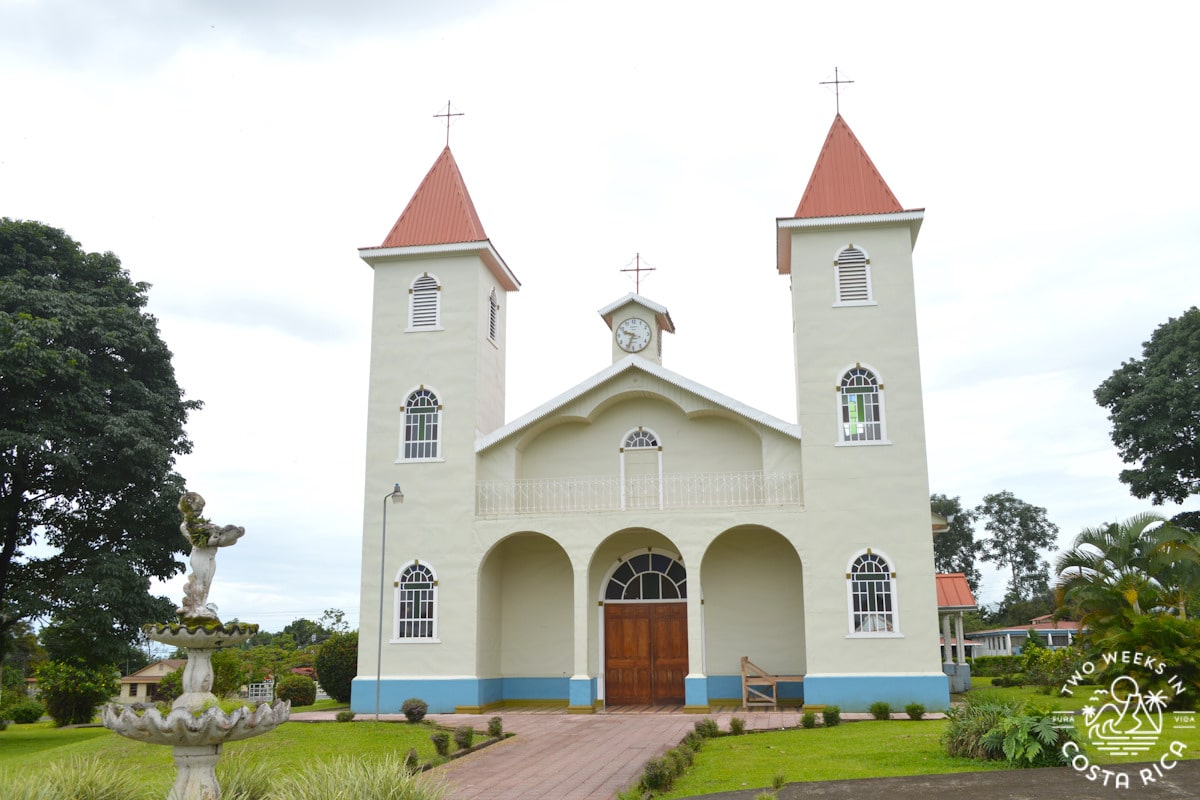
Traditional Wedding Attire
Today, Costa Rican wedding attire may look similar to what you’re used to or see in the movies. But back in the day, it was a bit different.
Bride & Groom Attire
Traditionally, we learned that a Costa Rican bride would wear a black silk dress instead of white. Black symbolized the seriousness and permanence of the commitment (until death do us part).
The groom traditionally would wear a white shirt that had been hand-embroidered by his bride-to-be. This represented her devotion and the time she had invested in preparing for their union.
While these customs are less common in modern Costa Rican weddings, some couples still incorporate parts of these elements to honor their cultural heritage. It could be a black ribbon around the bride’s waist or an embroidered handkerchief in the groom’s pocket, for example.
In the Tico weddings we have attended, the brides have worn white dresses and the grooms have worn black suits.
Wedding Guest Attire
Nothing we found on the internet told us what to wear to a Costa Rican wedding. But luckily, in the 8 suitcases we moved here with, we had a nice black dress with white flowers on it for Jenn, and a dress shirt, tie, and khaki pants for Matt. These outfits worked out well for the first wedding and we wore something similar for the second wedding. Our oldest son (age 3 at the time) wore a button-up shirt and jeans to the second wedding.
If you’re invited to a very fancy wedding venue in Costa Rica, you may need to wear something equally impressive like an evening gown or suit. But for our purposes at two smaller weddings, just dressing up worked out well.
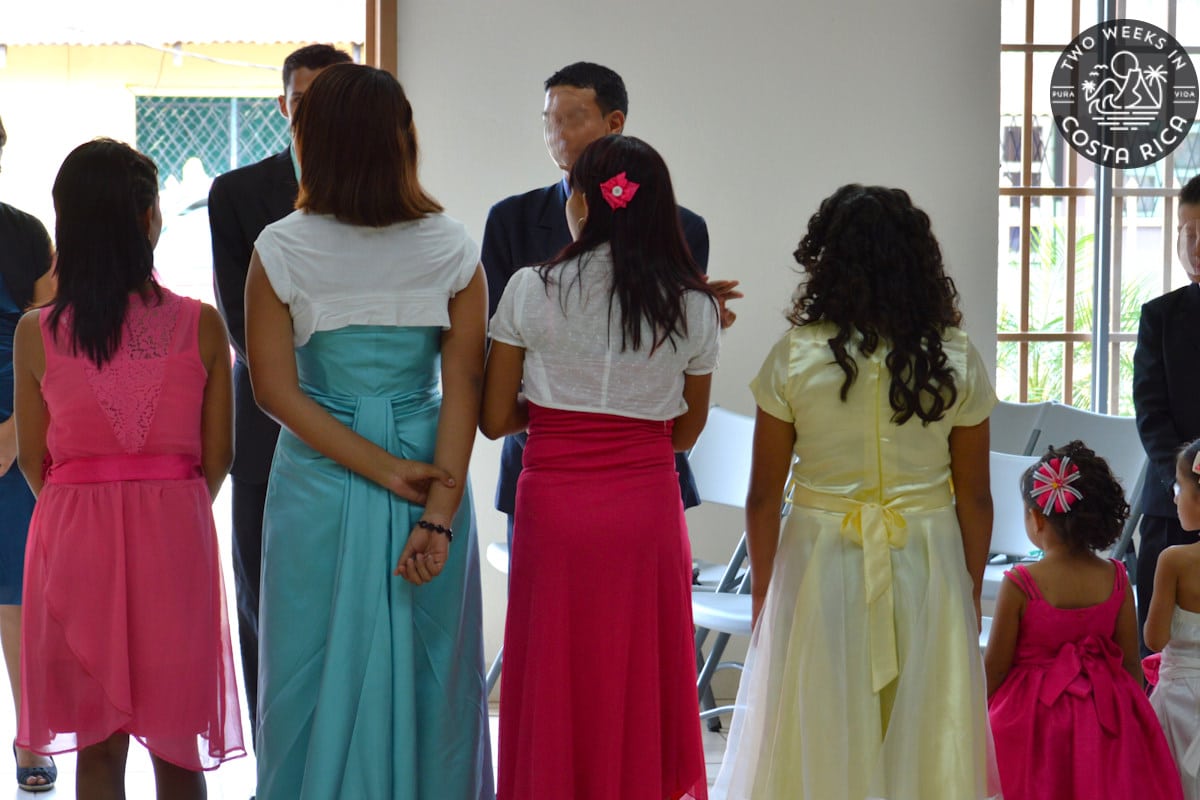
Gift-Giving Customs
Wedding gifts in Costa Rica follow similar customs as other countries. Money gifts are common and appreciated. Cash is often given in envelopes during the reception. We tucked some money into a personalized card for both weddings.
Household items and gifts for setting up the new home are also traditional choices. Bridal registries are available at a few stores in Costa Rica, but are much less common, especially outside San Jose.
Reception Celebrations
Costa Rican wedding receptions are known for their festive atmosphere with plenty of music, dancing, and food. Depending on the couple, these celebrations can last well into the night, with guests of all ages participating in the festivities.
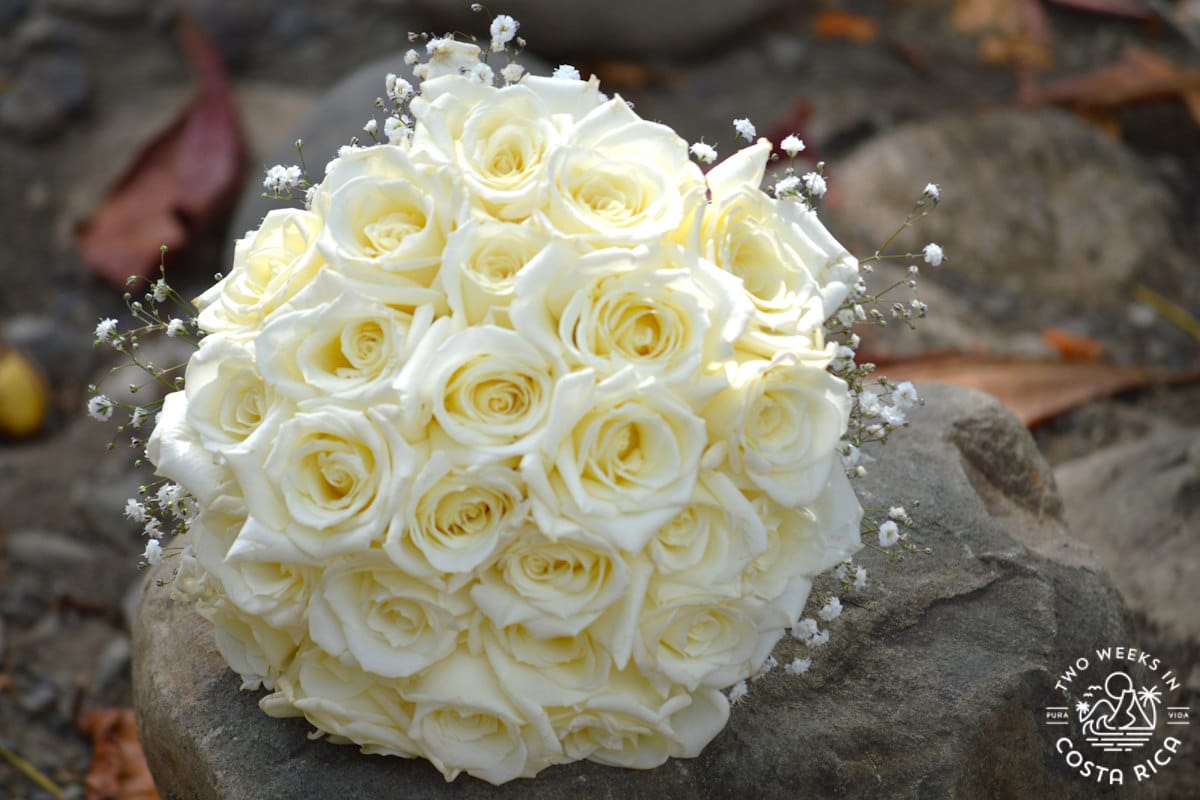
Money Dance
A fun tradition during the reception of a Costa Rican wedding is something called the money dance. This is when friends and relatives get to dance with the bride or groom. As each person goes up, they stuff colones (Costa Rica’s currency) into a basket or suit pocket.
The funds from this dance help the couple start off their marriage with a little extra cash in the bank.
Food & Hospitality
For Roy’s wedding, we were invited to a neighbor’s home for the reception. Everyone sat around together while we ate and drank. On the menu was arroz con pollo, the largest portion of rice pudding you’ve ever seen, and wedding cake for dessert.
To drink, we had an amazing concoction of diced tropical fruit in sweetened water. So refreshing! One tradition we had read about was that giving large portions showed respect. We definitely felt respected after!
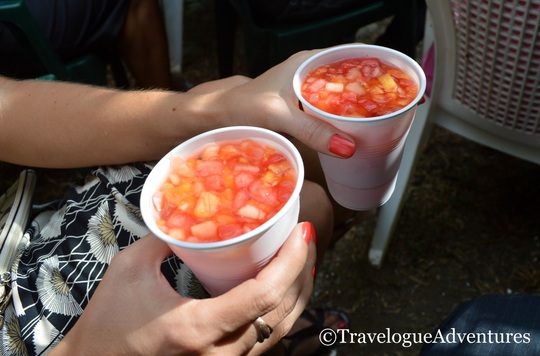
For our neighbor’s wedding, the reception was held at the church’s recreational hall. The family had set up elaborate decorations and made it look really intimate. They had a big buffet with rice, meat, vegetables, and other traditional foods. There was also a big table with drinks.
One of the most interesting things we observed at both weddings was that the bride and groom helped serve food and drinks to their guests. In the United States, the emphasis is definitely on the bride and groom not lifting a finger, so the contrast was stark to us. We can’t say if this is typical but it could relate to the importance of respecting your guests.
Dancing
The first Costa Rican wedding we attended was during the day and the reception was very mellow. The second one was much more upbeat with a DJ and lots of dancing. While the music was in Spanish, it was very similar to weddings we have attended with some upbeat songs that get most guests out on the dance floor and some others that are only for a specific audience. They mixed in some romantic slow dances too!
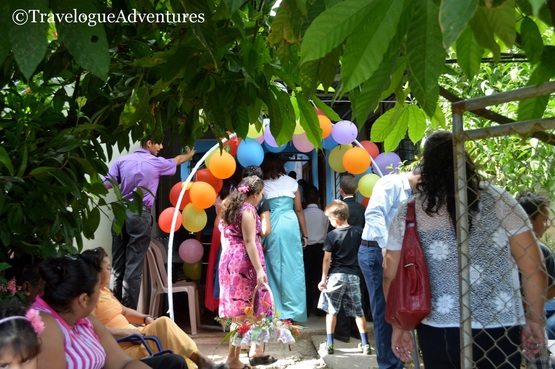
Conclusion
Overall, attending these Costa Rican wedding celebrations was very similar to what we are used to. Every bit of it may have been in another language and there certainly were some cultural differences, but the most important things were the same–family, respect, love, and celebration. They were both a wonderful glimpse into the country’s rich cultural heritage. We hope this post has helped you if you are planning to attend a wedding in Costa Rica.
Have something to share about a Costa Rican wedding you’ve attended? Leave a comment below.
Looking for more information to help you plan? Check out these posts:
Costa Rica Honeymoon Itinerary – Plan the perfect romantic getaway in Costa Rica.
Hot Springs in Costa Rica – Relax and unwind at Costa Rica’s natural thermal pools, perfect for couples seeking a romantic retreat.
Living in Costa Rica – Our section about moving to Costa Rica and living here for over 10 years, including cultural insights and practical advice.
Things to Do – Looking for fun activities to do after a wedding celebration in Costa Rica? Browse our Things to Do category with 150+ articles.


